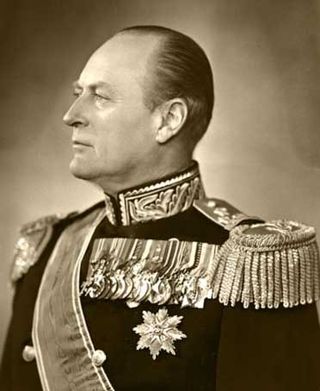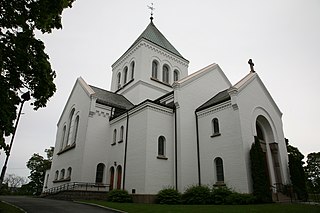
NRK, also known as the Norwegian Broadcasting Corporation, is the Norwegian government-owned radio and television public broadcasting company, and the largest media organisation in Norway. All other TV channels, broadcast from Norway, were banned between 1960 and 1981. NRK broadcasts three national TV channels and thirteen national radio channels on digital terrestrial television, digital terrestrial radio and subscription television. All NRK radio stations are streamed online at NRK.no, which also offers an extensive TV service. NRK is a founding member of the European Broadcasting Union.

Thorbjørn Egner was a Norwegian playwright, songwriter and illustrator known principally for his books, plays and musicals for children. He is principally associated with his narratives for children including Karius og Baktus (1949) and Folk og røvere i Kardemomme by (1955).

When the Robbers Came to Cardamom Town is a 1955 Norwegian children's book written and illustrated by Thorbjørn Egner, which tells the story of Kardemomme by. It is considered one of the most important works in Norwegian children's literature. The book includes many songs which are connected to the story. The story has been adapted into a play and television program. The criminologist Nils Christie considered that Egner had contributed significantly to criminology in Norway due in part to this book.
NBU-prisen is a prize which is awarded by the Norwegian Writers for Children to a person or institution who had produced award-winning work in children's or youth literature in Norway. It is awarded every year to a Norwegian author or organization. The actual prize is a work of art, typically created by an illustrator of children’s books.
NRK Super is a Norwegian TV and radio channel aimed at children, run by the Norwegian Broadcasting Corporation. The TV channel is broadcast on the digital terrestrial network, from 6:30am to 7:30pm, and was launched 1 December 2007. The NRK Super radio channel is broadcast on DAB radio and the internet, and was originally named NRK Barn. It was launched on 16 October 2007.

Einar Økland is a Norwegian poet, playwright, essayist and children's writer.

Thorbjørn Egners lesebøker were a series of sixteen readers for elementary school written by Norwegian author Thorbjørn Egner. Egner spent 25 years working on the series – consisting of collected literature as well as his own stories and illustrations – and they were published in 1950–1972. The books were intended for children aged 8–15, which at the time corresponded to grades 2nd–9th. Among the recurring characters was the young boy Ola-Ola, who grew up on a farm on the Norwegian countryside, but later moved to the city and had to adapt to a new life. Other stories took place in far-away lands, reminiscent of the environment in Egner's celebrated When the Robbers Came to Cardamom Town. There was also a selection of songs and poems in between the stories.
Events in the year 1984 in Norway.

Sigurd Bødtker was a Norwegian theatre critic.
Carl Fredrik Johannes Bødtker was a Norwegian engineer and radio personality.

Sverre Malling is a Norwegian visual artist. His work references classical art, botany, the occult, psychedelia, folk art and children’s illustrations.

Norwegian of the Century was a poll carried out by the Norwegian Broadcasting Corporation in 2005, the 100-year anniversary of Norwegian independence. The poll was SMS-based and over 400,000 Norwegians voted over the course of the year. To qualify as "Norwegian of the Century", the nominee must have lived between 1905 and 2005. All Norwegians were eligible for nomination, and there were initially 600 people on the list. A "Great Norwegian Committee" consisting of Nils Arne Eggen, Astrid Nøklebye Heiberg, Guri Hjeltnes, Harald Norvik, Erling Sandmo and Cathrine Sandnes narrowed the list down to 50. Another poll was conducted, again SMS-based, with the results presented live on NRK1 on 17 December 2005. The winner, with 41% of the vote, was King Olav V. Former Prime Minister Einar Gerhardsen was second with 24%, followed by Erik Bye with 15%. The results for the top 50 spots were as follows:
Helge Sverre Nesheim was a Norwegian radio and television host.

Dagsnytt Atten is a daily news magazine from Norwegian radio station NRK P2. Broadcast every weekday at 18:00, the programme hosts discussions and debates on the topics of the day featuring politicians and other Norwegian figures. Dagsnytt Atten is broadcast on NRK P2 and NRK Alltid nyheter. The programme has also been broadcast on NRK2 television since 2007, when television cameras were installed in the radio studio and in the control room. When guests appear by phone, a photograph of the person is usually displayed for the television audience. Although it is a radio programme, Dagsnytt Atten has a larger audience on TV than on radio. It had about 100,000 viewers a day on TV in 2015 and around 60,000 listeners on radio.

Trond-Viggo Torgersen is a Norwegian physician, broadcaster, television host, actor, comedian, singer, songwriter, artist and former children's ombudsman.
Thorbjørn Harr is a Norwegian actor.

Ullern Church is a cruciform Romanesque church on the Holgerslyst property in the Ullern borough of Oslo, Norway. It is the parish church for the Ullern congregation in the Vestre Aker Deanery of the Diocese of Oslo.
The following events occurred in radio in 2010.
Håkon Karlsen was a Norwegian journalist.
Kathrine Johnsen was a Norwegian Sámi teacher and employed at public broadcasting service NRK Sápmi. She is a pivotal figure in the promotion and support of Sámi languages and culture in the post-World War II period and has been referred to as "the Mother of the Sámi Radio".










